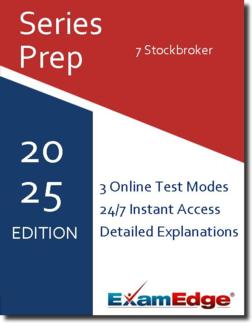Series 7 Stockbroker (Series7 ) Practice Tests & Test Prep by Exam Edge - Topics
Based on 25 Reviews
- Real Exam Simulation: Timed questions and matching content build comfort for your Series 7 Stockbroker test day.
- Instant, 24/7 Access: Web-based Series 7 General Securities Representative Exam practice exams with no software needed.
- Clear Explanations: Step-by-step answers and explanations for your Series exam to strengthen understanding.
- Boosted Confidence: Reduces anxiety and improves test-taking skills to ace your Series 7 General Securities Representative Exam (Series7 ).

Understanding the exact breakdown of the Series 7 General Securities Representative Exam test will help you know what to expect and how to most effectively prepare. The Series 7 General Securities Representative Exam has 250 multiple-choice questions The exam will be broken down into the sections below:
| Series 7 General Securities Representative Exam Exam Blueprint | ||
|---|---|---|
| Domain Name | % | Number of Questions |
| Seeks Business for the Broker-Dealer through Customers and Potential Customers | 27% | 68 |
| Evaluates Customers’ Other Security Holdings, Financial Situation and Needs, Financial Status, Tax Status, and Investment Objectives | 11% | 28 |
| Opens Accounts, Transfers Assets, and Maintains Appropriate Account Records | 11% | 28 |
| Provides Customers with Information on Investments and Makes Suitable Recommendations | 28% | 70 |
| Obtains and Verifies Customer’s Purchase and Sales Instructions, Enters Orders, and Follows Up | 23% | 58 |


